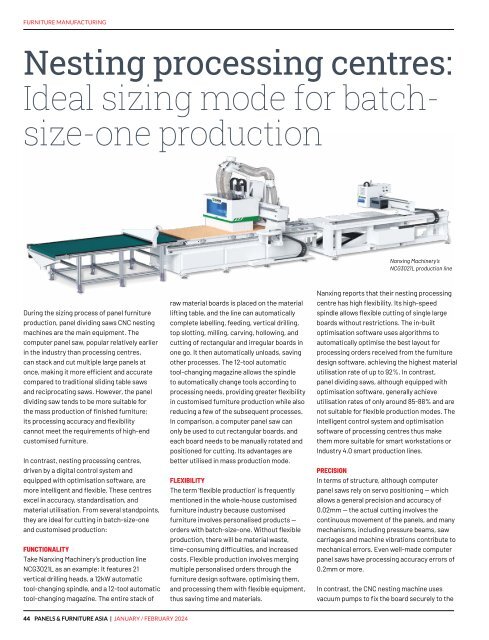Panels & Furniture Asia January/February 2024
Panels & Furniture Asia (PFA) is a leading regional trade magazine dedicated to the woodbased panel, furniture and flooring processing industry. Published bi-monthly since 2000, PFA delivers authentic journalism to cover the latest news, technology, machinery, projects, products and trade events throughout the sector. With a hardcopy and digital readership comprising manufacturers, designers and specifiers, among others, PFA is the platform of choice for connecting brands across the global woodworking landscape.
Panels & Furniture Asia (PFA) is a leading regional trade magazine dedicated to the woodbased panel, furniture and flooring processing industry. Published bi-monthly since 2000, PFA delivers authentic journalism to cover the latest news, technology, machinery, projects, products and trade events throughout the sector. With a hardcopy and digital readership comprising manufacturers, designers and specifiers, among others, PFA is the platform of choice for connecting brands across the global woodworking landscape.
Create successful ePaper yourself
Turn your PDF publications into a flip-book with our unique Google optimized e-Paper software.
FURNITURE MANUFACTURING<br />
Nesting processing centres:<br />
Ideal sizing mode for batchsize-one<br />
production<br />
Nanxing Machinery’s<br />
NCG3021L production line<br />
During the sizing process of panel furniture<br />
production, panel dividing saws CNC nesting<br />
machines are the main equipment. The<br />
computer panel saw, popular relatively earlier<br />
in the industry than processing centres,<br />
can stack and cut multiple large panels at<br />
once, making it more efficient and accurate<br />
compared to traditional sliding table saws<br />
and reciprocating saws. However, the panel<br />
dividing saw tends to be more suitable for<br />
the mass production of finished furniture;<br />
its processing accuracy and flexibility<br />
cannot meet the requirements of high-end<br />
customised furniture.<br />
In contrast, nesting processing centres,<br />
driven by a digital control system and<br />
equipped with optimisation software, are<br />
more intelligent and flexible. These centres<br />
excel in accuracy, standardisation, and<br />
material utilisation. From several standpoints,<br />
they are ideal for cutting in batch-size-one<br />
and customised production:<br />
FUNCTIONALITY<br />
Take Nanxing Machinery’s production line<br />
NCG3021L as an example: It features 21<br />
vertical drilling heads, a 12kW automatic<br />
tool-changing spindle, and a 12-tool automatic<br />
tool-changing magazine. The entire stack of<br />
raw material boards is placed on the material<br />
lifting table, and the line can automatically<br />
complete labelling, feeding, vertical drilling,<br />
top slotting, milling, carving, hollowing, and<br />
cutting of rectangular and irregular boards in<br />
one go. It then automatically unloads, saving<br />
other processes. The 12-tool automatic<br />
tool-changing magazine allows the spindle<br />
to automatically change tools according to<br />
processing needs, providing greater flexibility<br />
in customised furniture production while also<br />
reducing a few of the subsequent processes.<br />
In comparison, a computer panel saw can<br />
only be used to cut rectangular boards, and<br />
each board needs to be manually rotated and<br />
positioned for cutting. Its advantages are<br />
better utilised in mass production mode.<br />
FLEXIBILITY<br />
The term ‘flexible production’ is frequently<br />
mentioned in the whole-house customised<br />
furniture industry because customised<br />
furniture involves personalised products —<br />
orders with batch-size-one. Without flexible<br />
production, there will be material waste,<br />
time-consuming difficulties, and increased<br />
costs. Flexible production involves merging<br />
multiple personalised orders through the<br />
furniture design software, optimising them,<br />
and processing them with flexible equipment,<br />
thus saving time and materials.<br />
Nanxing reports that their nesting processing<br />
centre has high flexibility. Its high-speed<br />
spindle allows flexible cutting of single large<br />
boards without restrictions. The in-built<br />
optimisation software uses algorithms to<br />
automatically optimise the best layout for<br />
processing orders received from the furniture<br />
design software, achieving the highest material<br />
utilisation rate of up to 92%. In contrast,<br />
panel dividing saws, although equipped with<br />
optimisation software, generally achieve<br />
utilisation rates of only around 85-88% and are<br />
not suitable for flexible production modes. The<br />
intelligent control system and optimisation<br />
software of processing centres thus make<br />
them more suitable for smart workstations or<br />
Industry 4.0 smart production lines.<br />
PRECISION<br />
In terms of structure, although computer<br />
panel saws rely on servo positioning — which<br />
allows a general precision and accuracy of<br />
0.02mm — the actual cutting involves the<br />
continuous movement of the panels, and many<br />
mechanisms, including pressure beams, saw<br />
carriages and machine vibrations contribute to<br />
mechanical errors. Even well-made computer<br />
panel saws have processing accuracy errors of<br />
0.2mm or more.<br />
In contrast, the CNC nesting machine uses<br />
vacuum pumps to fix the board securely to the<br />
44 PANELS & FURNITURE ASIA | JANUARY / FEBRUARY <strong>2024</strong>


















